Manage/ Add/ Edit/ Delete/ Control Unified Task Board
Introduction
Task management module is a unified board that shows tasks from all projects. Different users will see different things based on their permissions. For example, the PMO Administrator will see tasks for all projects. A project manager will see the tasks for all projects he is managing, while a resource will only see the tasks assigned to her. A resource manager will see the tasks for all of his subordinates.
The board shows a consolidated view of all project and non-project tasks. Users can add non-project tasks, issues, risks, and actions by using the tools in this module.
Steps:
- Click on Taskboard Icon.

- First Column of your Taskboard titled (Backlog) will show up. Swipe to the right side to view the other columns of your taskboard which are; To Do, Doing, Done.
Tip: The tasks in this board go into a life cycle made up of four stages:
- Backlog, which includes the tasks required but not for immediate action (usually not to be done within this week).
- To-Do, in this phase we put the tasks that we need to finish this week.
- Doing, this column is for the work in progress (WIP) which we are currently working with.
- Done, includes the complete tasks.

- Click on Advanced Filters action which allows us to define additional filtering criteria, like show my cards only, filtering by project name, card type, and assignees.

- When we are in filtering mode the filter icon, will appear in yellow.
Tip: To remove the filtering mode, clear filters.

- Any of the cards displayed includes the project name, task name and assignees. For more details on card information, please review the upcoming steps.
- This is a visual indicator of the different card type, so there is a specific icon for tasks, actions, issues, and risks
- The top of the card shows either the project name if this was a project related card, or it will be marked as “None Project” if this card doesn’t belong to a specific project.
- The dotted menu allows us to move the cards into the different stages on the board. If this was a non-project card, we can also delete the card using this menu.
- In the middle of the card we can see the start date and finish date.
- Here we have visual indicators to show if we have comments, attachments, and subtasks. If any of those components are not in the card, the related icon will disappear.
- In the Avatar part we see the pictures of resource(s) who are assigned to this task. This is a quick and easy way to spot who is doing what in the taskboard. If the Avatar icon is shaded, it means the resource is assigned to or delegated to a checklist item (subtask).
- Finally, we have the card title which is clickable and when clicked will open up the card for further editing.
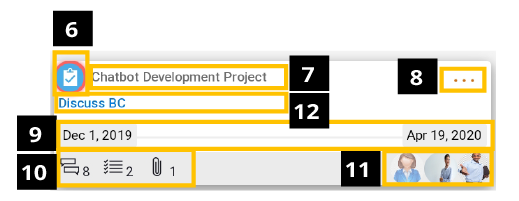
- Now we are inside the card and we can see the card title, Percentage of Completion, WBS code…etc. Notice that when this card is a task originated from a project, this data is read-only.
- Using the “Add an attachment” link you can attach any files to the tasks and you can also view, download, or delete already attached files.
- The subtasks section allows us to break up the task into subtasks or actions, we can assign one or more assignees. Tip: This approach allows delegating the task to additional assignees, other than the original assignee fixed in the project schedule.
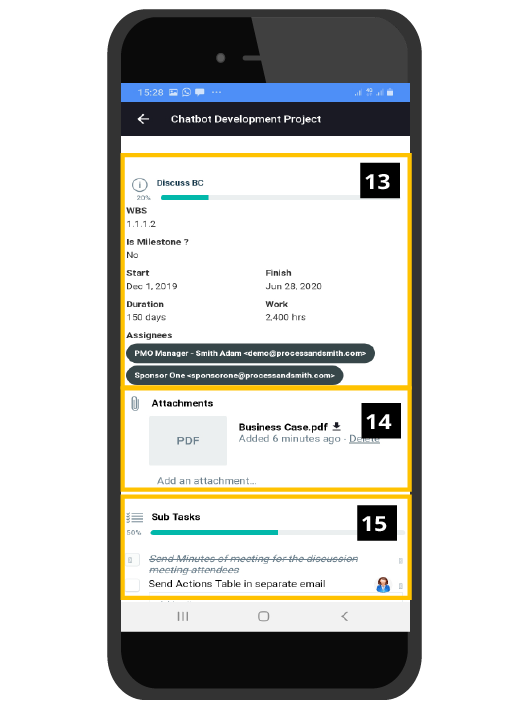
- Finally, we can add comments to the card to indicate latest updates. In the comment you can mention other resources using the @ symbol and typing the resource name. Mentioned resources will get a notification on their inbox, mobile app, and web app notifications center.
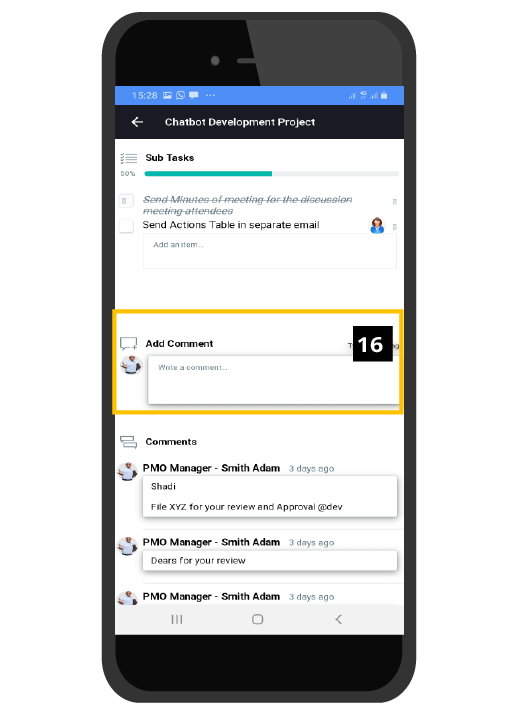
- There is an Activity Log too.
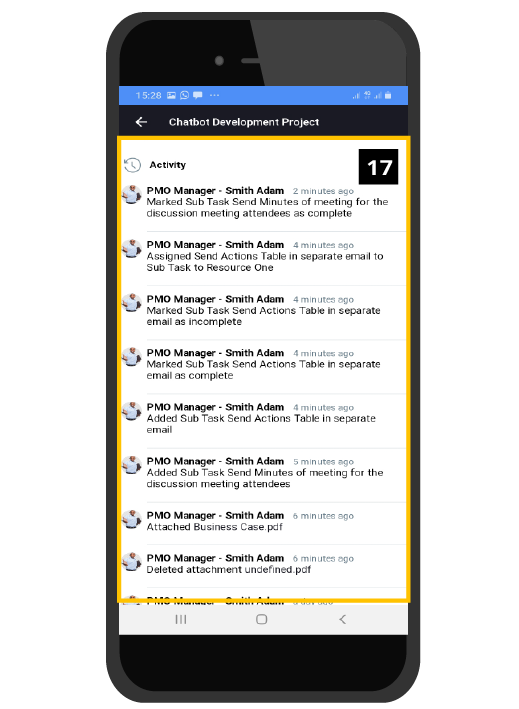
- To create a new none-project card, click the FAB menu so you can use the FAB menu. you will be able to do the following choices;
- Add None Project Task
- Add None Project Risk
- Add None Project Action
- Add None Project Issue
You can use any of the four options to create the cards with different types as needed. Notice that those actions, tasks, and issues are not related to a specific project, instead we use them for non-project work tracking. For example try to create a new none-project task.
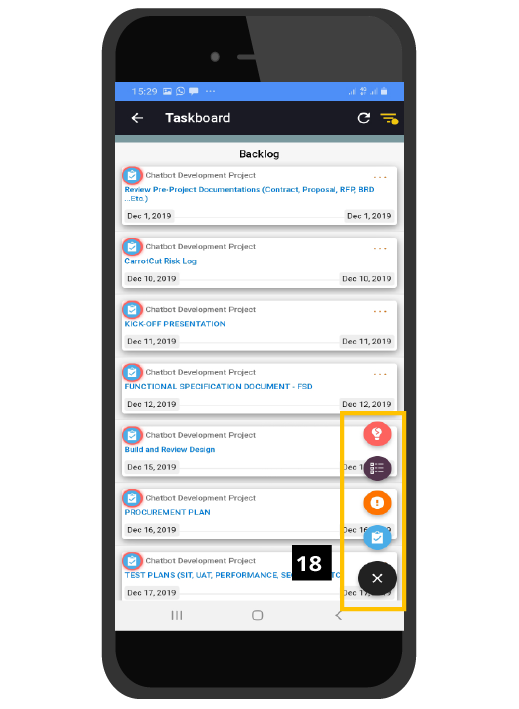
- The card info, title and type.
- In this section we can define the start date, finish date, duration, and the work.
- In this section we can click the people icon to select one or more assignees for this card. By clicking the small x icon on any resource we can remove this resource from the assignees list.
- We can define the severity and the reported by.
- Add task Description related to this card.
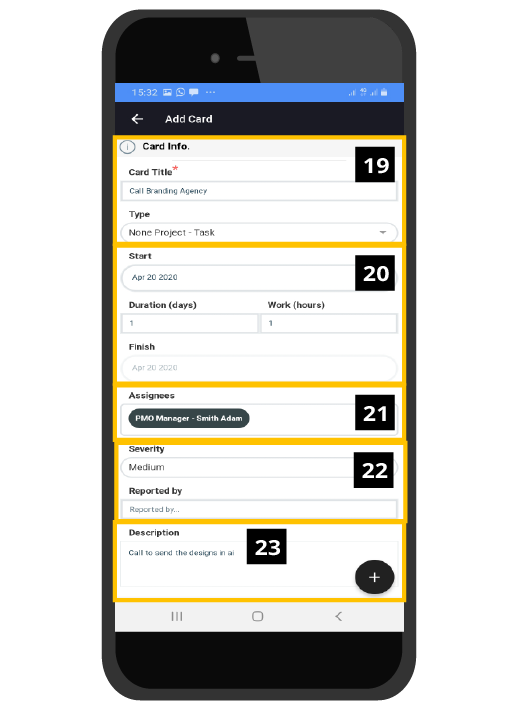
- In the attachments section we can upload, download, and remove attachments specific to this card.
- In the subtasks section we can break up the card into subtasks, or to-do list and assign or delegate the subtasks to different resources.
- Finally in the comments sections we can define comments and mentioned other resources to grab their attention to this card.

